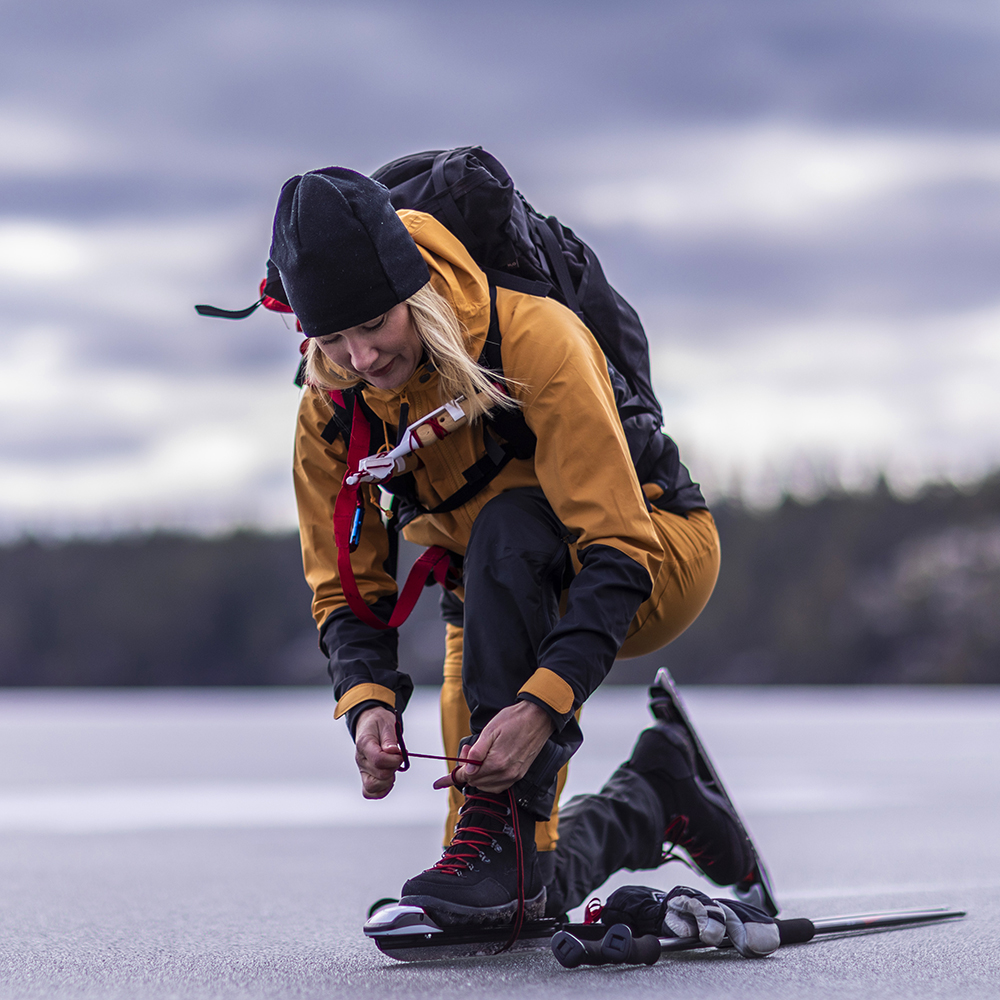Guide to Nordic Tour Skating
Nordic tour skating is becoming an increasingly popular activity during the winter season, especially in Norway and Sweden.
Cold days without snow allows many people to turn to tour skating instead of skiing. If you haven't tried it yet, we highly recommend it! It's known as “an ointment for the soul” to glide on frozen, mirror-like water; the only thing you hear is the wind and the steel of your skates sliding across the ice.
If the conditions are right, you can effortlessly cover several kilometers. It is also a very unique way to experience nature. And it's not particularly difficult to learn either.
Curious about nordic skating? Watch the short film, “A nordic skater” here.
Nordic skating has its origin in Sweden, but is starting to take-off in Norway as well. With water and lakes from north to south, tour skating has great potential to become a popular low key activity when the snowfall awaits.
Tour skating is not an extreme sport, but an activity that can give you an excellent feeling of achievement and connection to nature. The length of the tours and the speed are chosen according to your skill level and experience, so you don’t need to be an expert right away.
What are nordic skates?
Forget the cold and uncomfortable experiences with classic hockey skates from when you were a kid. Tour skates are something else! They provide a low center of gravity and good stability. You can skate for hours without pain or cramping in your feet.
Tour skates may resemble speed skates. The steel is long, and provides the best possible glide on the ice. Unlike speed skates, tour skates do not have an upper part (the shoe part). On the tour skates, you use your own ski boots and normal mountain ski bindings, which means you can use a pair of solid mountain ski boots that warms and sits well on the foot.
See our selection of ski- and ice skate boots here
Safety first!
The ice conditions vary a lot compared to snow, and unfortunately accidents do happen, but they can be avoided with the right equipment.
Everyone is responsible for their own safety, and you must always check the ice conditions before going out. Generally, there is no one reporting if the ice is "safe" or "unsafe". There are usually sections of both “strong” and “weak” ice in all waters throughout the season.
Good safety equipment and good safety routines will keep you safe, but it is also important to know what to do if accidents do happen so make sure you have the knowledge required.
Ice quality depends on the season and rainfall
The vast majority of water, and some fjords, freeze over during the winter. Including salt water. This ice is called black ice, which forms when the water crust itself freezes, and is stronger than the ice formed by frozen sleet and snow. This type of ice does not have to be thick to carry a person, but we recommend at least 10 cm of black ice to be safe. We also recommend avoiding inlets, outlets, narrow straits, headlands, shoals, bridges and reed areas.
With the right safety equipment, training, and number of people, you can stretch the limit down to 5 cm. This increases the risk of going through the ice significantly, and especially on fjord ice and river ice, because this varies much more than the lake ice.
Follow the ice alerts on Regobs, varsom.no and i iskart.no, which have been developed by the Norwegian Directorate of Water Resources and Energy (NVE).
Don’t worry, all the safety focus is easy once you get the hang of it and Nordic tour skating is great fun. Picture skating in the winter sun, with kilometer upon kilometer of shining ice in front of you. It's just a matter of getting started!
Below the picture we have listed what equipment you should bring with you. Have a good trip!

Gear for nordic skating
Remember that you are responsible for ensuring that your safety is adequately taken care of when you're out skating. There is no such thing as safe ice, only safe skaters.
Make sure you acquire adequate knowledge about ice, don't go alone - and bring safety gear that you know how to use. There is not much you need, but an absolute minimum is ice spikes (stingers) that you carry around your neck, a lifeline to help either you or others, ice poles and a dry bag with a dry change of clothes.
Ice pole
An ice pole is a pole with a strong spike that is designed so that you can break through 5 cm of black freshwater ice (steel ice) with one hit. That is the lower limit of what you should normally skate on. Sea ice (salt water ice) should be somewhat thicker.
Learn how to handle the poles and know how hard you have to cut to get through 5 cm of steel ice. The pole also gives you support when crossing rough terrain and makes it possible to travel faster and safer over areas with uneven surfaces.
Backpack for Ice Skating
In your backpack you must have a complete change of necessary clothes in a waterproof bag, in addition to food and water. The backpack is also your life jacket if an accident occurs! In order to function as a life jacket, it must have a hip belt and crotch strap.
Ice Claws or Ice Spikes
The ice spikes should be very easily accessible, even with gloves on. Typically carried around your neck.
Whistle
A whistle allows you to attract attention easier. The whistle should be attached to the ice spikes to be easily accessible.
Lifeline
The lifeline must be positioned so that you can easily reach it, even with the backpack on. A good recommendation is the outer pocket of the backpack. One end of the lifeline must be attached to the backpack or the hip belt.
Other equipment for tour skating
In addition to mandatory safety equipment, it is advantageous to use a helmet and knee- and elbow protection.
Skate groups
Theory is good, but practice is better. Get in touch with local Nordic skating groups in your area. Some also offer safety courses regularly. Skiforeningen has a touring skating group, run by volunteers.
To summarize; here is the list of what you need:
- Ice pole
- Backpack
- Ice spikes
- Whistle
- Lifeline
- Optional: Helmet, knee pads, and elbow pads
Have fun skating!
Lundhags video guides on ice skating
In Lundhags we have made a series of films, so you can learn more about ice skating and which products are right for you.
Ski and ice skating shoes
Hiking poles
Other equipment for touring

